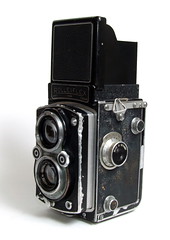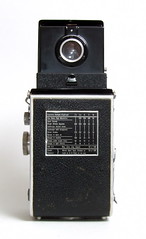Difference between revisions of "Rolleiflex Automat Model 3"
m |
Hanskerensky (talk | contribs) (Removed Category:6x6 as German 6x6 TLR is in it as a sub-category) |
||
| (19 intermediate revisions by 3 users not shown) | |||
| Line 1: | Line 1: | ||
| + | |||
| + | {{Flickr_image | ||
| + | |image_source= http://www.flickr.com/photos/jackvts/11520245054/in/pool-camerawiki/ | ||
| + | |image= http://farm6.staticflickr.com/5493/11520245054_3bda7c772f_n.jpg | ||
| + | |image_align= center | ||
| + | |image_text= | ||
| + | |image_by= Jacks_ON | ||
| + | |image_rights= wp | ||
| + | }}{{br}} | ||
{{Flickr_image | {{Flickr_image | ||
|image_source= http://www.flickr.com/photos/s-demir/4442107767/in/pool-camerawiki/ | |image_source= http://www.flickr.com/photos/s-demir/4442107767/in/pool-camerawiki/ | ||
| − | |image= http://farm5. | + | |image= http://farm5.staticflickr.com/4027/4442107767_bbf1c86e71.jpg |
|image_align= right | |image_align= right | ||
|image_text= Rolleiflex Automat Model 3, c.1947. | |image_text= Rolleiflex Automat Model 3, c.1947. | ||
| Line 17: | Line 26: | ||
Many photographers still shoot with Rolleiflex TLR film cameras and black-and-white film. | Many photographers still shoot with Rolleiflex TLR film cameras and black-and-white film. | ||
==Specifications== | ==Specifications== | ||
| − | *Model: Model 3 = Type | + | *Model: Model 3 = Type K4, build 632 <ref>[http://www.rolleiclub.com/cameras/tlr/info/automat.shtml Int.Rollei Club Rolleiflex Automat]</ref> |
| − | *Produced between | + | *Produced between 1939-1949, about 38.600 units |
*Format :120 roll (B2), picture size 6x6cm <ref>The camera could be used with Rolleikin I to use 35mm film or with the special glass plate film adapter</ref> | *Format :120 roll (B2), picture size 6x6cm <ref>The camera could be used with Rolleikin I to use 35mm film or with the special glass plate film adapter</ref> | ||
| − | *Taking lens : [[ | + | *Taking lens :<br>[[Carl Zeiss]] [[Tessar]] 1:3.5 f=7.5cm. <br> or : [[Carl Zeiss]] Oberkochen Opton Tessar 1:3.5 f=7.5cm.<br> or : [[Schneider-Kreuznach]] Xenar 1:3.5 f=7.5cm. <br>filter: Bayonet size 1; Aperture: f/3.5 - f/16 |
| − | *Finder lens: | + | *Finder lens: [[Triplet]] f/2,8 7.5cm. filter: Bayonet size 1 |
*Focusing: on matte glass screen, via a big knob on the left side of the camera, w/ DOF scale; Focus range: 0.85-20m +inf | *Focusing: on matte glass screen, via a big knob on the left side of the camera, w/ DOF scale; Focus range: 0.85-20m +inf | ||
*View finder: Waist level finder, w/ magnifying loop and sports eye level finder | *View finder: Waist level finder, w/ magnifying loop and sports eye level finder | ||
*Shutter: [[Compur]] - Rapid; speeds: 1 - 1/500 + T & B | *Shutter: [[Compur]] - Rapid; speeds: 1 - 1/500 + T & B | ||
*Cocking lever: also winds the film, with double exposure prevention | *Cocking lever: also winds the film, with double exposure prevention | ||
| − | *Frame counter: | + | *Frame counter: auto reset, above the winding lever |
*Flash PC socket: on the left lower corner of the camera, w /M-X lever; Flash sync at all speeds | *Flash PC socket: on the left lower corner of the camera, w /M-X lever; Flash sync at all speeds | ||
*Back cover: hinged, also removable with bottom plate, w/ exposure guide table | *Back cover: hinged, also removable with bottom plate, w/ exposure guide table | ||
| Line 33: | Line 42: | ||
{|class=plainlinks align="center" | {|class=plainlinks align="center" | ||
|| | || | ||
| − | + | {{Flickr_image | |
| − | + | |image_source= http://www.flickr.com/photos/s-demir/4442108025/in/pool-camerawiki/ | |
| − | |image= http://farm5. | + | |image= http://farm5.staticflickr.com/4065/4442108025_3db5e6daa5_m.jpg |
| − | + | |image_align= | |
| − | + | |image_text= | |
| − | + | |image_by= | |
| − | + | |image_rights= | |
| − | + | }} | |
|| | || | ||
{{Flickr_image | {{Flickr_image | ||
| − | |image_source= http://www.flickr.com/photos/s-demir/ | + | |image_source= http://www.flickr.com/photos/s-demir/4442107843/in/pool-camerawiki/ |
| − | |image= http://farm5. | + | |image= http://farm5.staticflickr.com/4020/4442107843_7ca6970900_m.jpg |
|image_align= | |image_align= | ||
|image_text= | |image_text= | ||
| Line 52: | Line 61: | ||
|| | || | ||
{{Flickr_image | {{Flickr_image | ||
| − | |image_source= http://www.flickr.com/photos/s-demir/ | + | |image_source= http://www.flickr.com/photos/s-demir/4442886026/in/pool-camerawiki/ |
| − | |image= http:// | + | |image= http://farm5.staticflickr.com/4056/4442886026_73f53c311f_m.jpg |
|image_align= | |image_align= | ||
|image_text= | |image_text= | ||
| Line 61: | Line 70: | ||
|- | |- | ||
|colspan=3 align="center"| Rolleiflex Automat Model 3, c.1947. | |colspan=3 align="center"| Rolleiflex Automat Model 3, c.1947. | ||
| − | <small>Images by Süleyman Demir {{ with permission }}</small> | + | <small>Images by {{image author|Süleyman Demir}} {{ with permission }}</small> |
|} | |} | ||
| − | ==Notes | + | ==Notes== |
<references/> | <references/> | ||
| + | |||
| + | {{br}} | ||
| + | == Bibliography == | ||
| + | * Claus Prochnow, Rollei Report 1, Braunschweig, Lindemanns Verlag, 1993, <nowiki>ISBN</nowiki> 3-89506-105-0. | ||
| + | |||
==Links== | ==Links== | ||
*[http://www.rolleiclub.com/cameras/tlr/info/automat.shtml Automat in International Rollei Club] | *[http://www.rolleiclub.com/cameras/tlr/info/automat.shtml Automat in International Rollei Club] | ||
| Line 72: | Line 86: | ||
*[http://en.wikipedia.org/wiki/Rolleiflex in Wikipedia] | *[http://en.wikipedia.org/wiki/Rolleiflex in Wikipedia] | ||
| − | [[Category:TLR]] [[Category: | + | [[Category:German 6x6 TLR]] |
| + | [[Category:Rollei]] | ||
| + | [[Category:R]] | ||
Revision as of 05:57, 26 June 2021

|
| image by Jacks_ON (Image rights) |

|
| Rolleiflex Automat Model 3, c.1947. image by Süleyman Demir (Image rights) |
Rolleiflex Automat Model 3 is a TLR film camera and manufactured by Franke & Heidecke, Braunschweig, Germany.[1] All Rolleiflex Automat series was produced between 1937-1956.
Automat name stands to introduced automatic film counter in 1937; this counter senses the thickness of the film backing to accurately begin counting frames, obviating the need for the ruby window that forced the photographer to read the frame number off the back of the film itself. This model won the Grand Prix award at the Paris World's Fair in 1937.
Rolleiflex TLR film cameras were most famous and the standard of news and studio photographers for decads. Many photographers still shoot with Rolleiflex TLR film cameras and black-and-white film.
Contents
Specifications
- Model: Model 3 = Type K4, build 632 [2]
- Produced between 1939-1949, about 38.600 units
- Format :120 roll (B2), picture size 6x6cm [3]
- Taking lens :
Carl Zeiss Tessar 1:3.5 f=7.5cm.
or : Carl Zeiss Oberkochen Opton Tessar 1:3.5 f=7.5cm.
or : Schneider-Kreuznach Xenar 1:3.5 f=7.5cm.
filter: Bayonet size 1; Aperture: f/3.5 - f/16 - Finder lens: Triplet f/2,8 7.5cm. filter: Bayonet size 1
- Focusing: on matte glass screen, via a big knob on the left side of the camera, w/ DOF scale; Focus range: 0.85-20m +inf
- View finder: Waist level finder, w/ magnifying loop and sports eye level finder
- Shutter: Compur - Rapid; speeds: 1 - 1/500 + T & B
- Cocking lever: also winds the film, with double exposure prevention
- Frame counter: auto reset, above the winding lever
- Flash PC socket: on the left lower corner of the camera, w /M-X lever; Flash sync at all speeds
- Back cover: hinged, also removable with bottom plate, w/ exposure guide table
- Others: Self-timer; Tripod socket 3/8 inch; Strap lugs
- Body: metal; Weight: 928g
|
|
| ||||||
| Rolleiflex Automat Model 3, c.1947.
Images by Süleyman Demir (Image rights) | ||||||||
Notes
- ↑ Engravings beneath the Rolleiflex logo: D.R.P. and serial no. D.R.P. means Deutsches Reichs Patent stating that this design or part of it was patented sometime between 1890-1945
- ↑ Int.Rollei Club Rolleiflex Automat
- ↑ The camera could be used with Rolleikin I to use 35mm film or with the special glass plate film adapter
Bibliography
- Claus Prochnow, Rollei Report 1, Braunschweig, Lindemanns Verlag, 1993, ISBN 3-89506-105-0.


